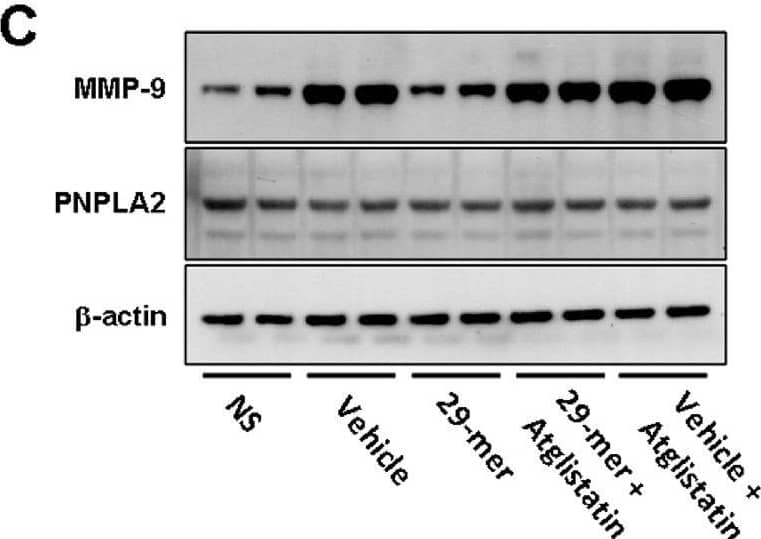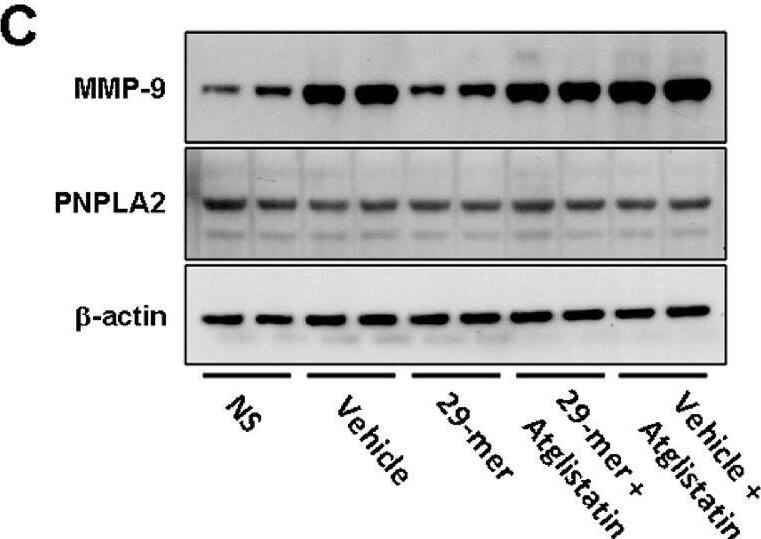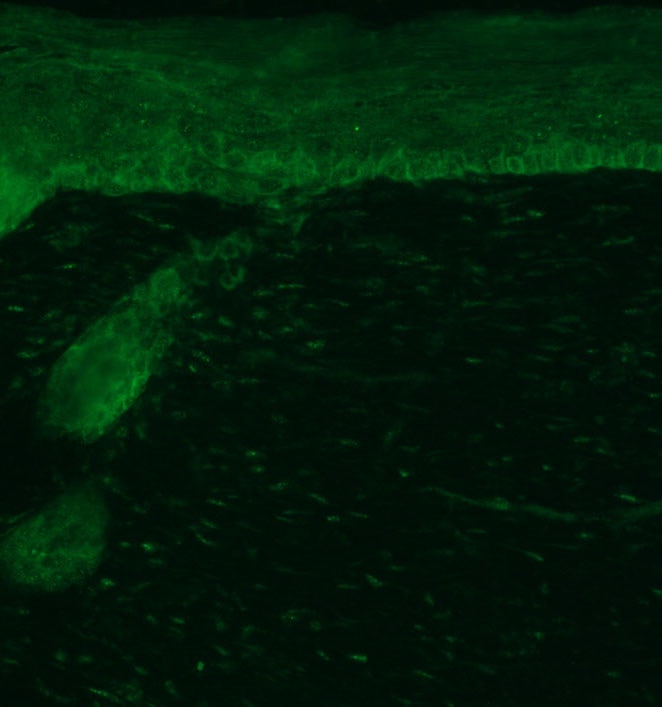Human/Mouse/Rat PEDFR/PNPLA2 Antibody Summary
Val162-Gly253
Accession # Q8BJ56
Applications
Please Note: Optimal dilutions should be determined by each laboratory for each application. General Protocols are available in the Technical Information section on our website.
Scientific Data
 View Larger
View Larger
Detection of Human and Mouse PEDF R/PNPLA2 by Western Blot. Western blot shows lysates of human adipose tissue and mouse adipose tissue. PVDF membrane was probed with 1 µg/mL of Sheep Anti-Human/Mouse/Rat PEDF R/PNPLA2 Antigen Affinity-purified Polyclonal Antibody (Catalog # AF5365) followed by HRP-conjugated Anti-Sheep IgG Secondary Antibody (Catalog # HAF016). A specific band was detected for PEDF R/PNPLA2 at approximately 55 kDa (as indicated). This experiment was conducted under reducing conditions and using Immunoblot Buffer Group 8.
 View Larger
View Larger
PEDF R/PNPLA2 in Mouse Kidney. PEDF R/PNPLA2 was detected in perfusion fixed frozen sections of mouse kidney using 15 µg/mL Sheep Anti-Human/Mouse/Rat PEDF R/PNPLA2 Antigen Affinity-purified Polyclonal Antibody (Catalog # AF5365) overnight at 4 °C. Tissue was stained with the Anti-Sheep HRP-DAB Cell & Tissue Staining Kit (brown; Catalog # CTS019) and counterstained with hematoxylin (blue). Specific labeling was localized to the plasma membrane of epithelial cells in tubules. View our protocol for Chromogenic IHC Staining of Frozen Tissue Sections.
 View Larger
View Larger
Detection of Mouse PEDF R/PNPLA2 by Simple WesternTM. Simple Western lane view shows lysates of mouse adipose tissue, loaded at 0.2 mg/mL. A specific band was detected for PEDF R/PNPLA2 at approximately 59 kDa (as indicated) using 10 µg/mL of Sheep Anti-Human/Mouse/Rat PEDF R/PNPLA2 Antigen Affinity-purified Polyclonal Antibody (Catalog # AF5365) followed by 1:50 dilution of HRP-conjugated Anti-Sheep IgG Secondary Antibody (Catalog # HAF016). This experiment was conducted under reducing conditions and using the 12-230 kDa separation system.
 View Larger
View Larger
Detection of Human PEDFR/PNPLA2/ATGL by Western Blot Loss-of-function analyses of PEDF in Bkid cells. (A) PEDF micro RNA (miR) expressing vector was transfected into Bkid cells. Immunoblot by anti-PEDF antibody showed the reduction of PEDF proteins by miRs. (B) The renal and the hepatic lesions of the results of the intracardiac injections of Bkid cells or Bkid+PEDFmiR cells. The adrenal metastasis was observed. Also, by Bkid cell injections, the renal metastasis was observed frequently (left, 12-positive/12), while no renal nodule was observed in Bkid+PEDFmiR injected mouse (right, 17-negative/18). The ruler is 1mm square. (C) The hepatic metastases of both cells were not inhibited with or without PEDF. (D) The section Hematoxylin/Eosin (H&E) staining of the similar samples to (B). The adrenal hypertrophy was observed both in Bkid- and Bkid+PEDFmiR-injected mouse organs. The renal metastatic lesion (met) was seen as the lighter color. The scale is 2 mm. (E) The hepatic metastasis. Both tumors had the cavity. (F) PEDF-immunohistochemistry (IHC) of the section (D). PEDF staining was observed inside of the adrenal gland cystic vesicle of Bkid tumors. The overall staining level of PEDF in Bkid tumor was higher than Bkid+PEDFmiR cells. The scale is 1 mm. (G) IHC for PEDF on paraffin sections of collagen gel-embedded 143B and 143B+PEDF cells. (H-L) The renal section IHC by various antibodies. (H) Anti-SPARC (osteonectin)-IHC indicates that the lesions are derived from the injected osteosarcoma. In the section of kidney from Bkid-injected mouse, there is SPARC-positive tumor both in kidney and adrenal gland sides. On the right, the kidney from Bkid+PEDFmiR-injected mouse had SPARC-positive cells only in adrenal gland. The scale indicates 100 µm. (I–L) The scale indicates 20 µm. (I) The higher magnified picture of the tissue surrounded glomerulus. There is SPARC-positive cells were seen around the glomerulus of Bkid-injected mouse (arrow), while no signal was seen in Bkid+PEDFmiR-injected mouse, (J) PEDF-IHC. PEDF was accumulated in the podocytes around the glomerulus. (K) 67kDa laminin receptor (lamR)-IHC. lamR is a potential PEDF receptor. Arrows indicated lamR signals in the podocytes around and the vein in the glomerulus. (L) CD31-IHC in glomerulus. (M, N) The liver section IHCs with CD31 antibody. The vascular formation was observed. (M) No closed blood vessel was seen in Bkid tumor (above). Near the tumor-liver boundary in Bkid sample (below). (N) The blood vessels could be seen as the closed oval form in Bkid+PEDFmiR tumor (above). Tumor-liver boundary of Bkid+PEDFmiR (below). There were a lot of the closed blood vessels (arrowheads). (O) The closed shapes of CD31-staining were counted only in the tumor regions, and the results were normalized by CD31-positive area. PEDF expression severely disturbed the formation of blood vessels (p=0.015). ad, adrenal gland; kid, kidney; met, metastatic lesion; liv, liver. Image collected and cropped by CiteAb from the following publication (https://pubmed.ncbi.nlm.nih.gov/35174090), licensed under a CC-BY license. Not internally tested by R&D Systems.
 View Larger
View Larger
Detection of PEDFR/PNPLA2 by Western Blot Effect of the 29-mer on the expression of MMP-9 in EDE. The schedule of induction of EDE is described in Fig. 2. (A) Representative immunofluorescence images showing MMP-9 in corneal and conjunctival epithelia after 14 days of EDE induction (n = 6 per group). (B) qPCR evaluates the levels of MMP-9 in the ocular surface epithelia (n = 6 per group). (C and D) Representative Western blots and densitometric analyses of MMP-9 and PEDF-R of ocular surface epithelia are shown from three independent experiments. Image collected and cropped by CiteAb from the following open publication (https://pubmed.ncbi.nlm.nih.gov/36201200), licensed under a CC-BY license. Not internally tested by R&D Systems.
 View Larger
View Larger
Detection of PEDFR/PNPLA2 by Western Blot Effect of the 29-mer on the expression of MMP-9 in EDE. The schedule of induction of EDE is described in Fig. 2. (A) Representative immunofluorescence images showing MMP-9 in corneal and conjunctival epithelia after 14 days of EDE induction (n = 6 per group). (B) qPCR evaluates the levels of MMP-9 in the ocular surface epithelia (n = 6 per group). (C and D) Representative Western blots and densitometric analyses of MMP-9 and PEDF-R of ocular surface epithelia are shown from three independent experiments. Image collected and cropped by CiteAb from the following open publication (https://pubmed.ncbi.nlm.nih.gov/36201200), licensed under a CC-BY license. Not internally tested by R&D Systems.
Reconstitution Calculator
Preparation and Storage
- 12 months from date of receipt, -20 to -70 °C as supplied.
- 1 month, 2 to 8 °C under sterile conditions after reconstitution.
- 6 months, -20 to -70 °C under sterile conditions after reconstitution.
Background: PEDFR/PNPLA2
PEDF R (Pigment epithelium derived factor receptor; also known as ATGL, PNPLA2, and Desnutrin) is a 55 kDa member of the PNPLA family of proteins. It is expressed in adipocytes, hepatocytes, skeletal muscle, and pigment epithelium. PEDF R specifically hydrolyses triglycerides, releasing long-chain fatty acids. Mouse PEDF R is described as being a 486 amino acid (aa) type II transmembrane (TM) protein. Its TM segment is stated to span aa 9-29. Alternatively, it may have a hydrophobic lipid-association domain between aa 267-295. It contains a palatin domain (aa 10-179) with a conserved GxSxG enzymatic motif. There are multiple splice forms. Two show alternate start sites at Met57 and Met232, while two others show a deletion of aa 163-196 and aa 253-308, respectively. Over aa 162-253, mouse PEDF R shares 98% and 93% aa sequence identity with rat and human PEDF R, respectively.
Product Datasheets
Citations for Human/Mouse/Rat PEDFR/PNPLA2 Antibody
R&D Systems personnel manually curate a database that contains references using R&D Systems products. The data collected includes not only links to publications in PubMed, but also provides information about sample types, species, and experimental conditions.
10
Citations: Showing 1 - 10
Filter your results:
Filter by:
-
Identification of Pigment Epithelium-Derived Factor Receptor (PEDF-R) Antibody Epitopes
Authors: Preeti Subramanian, Matthew Rapp, S. Patricia Becerra
Retinal Degenerative Diseases
-
Dynamic interplay between IL-1 and WNT pathways in regulating dermal adipocyte lineage cells during skin development and wound regeneration
Authors: Sun, L;Zhang, X;Wu, S;Liu, Y;Guerrero-Juarez, CF;Liu, W;Huang, J;Yao, Q;Yin, M;Li, J;Ramos, R;Liao, Y;Wu, R;Xia, T;Zhang, X;Yang, Y;Li, F;Heng, S;Zhang, W;Yang, M;Tzeng, CM;Ji, C;Plikus, MV;Gallo, RL;Zhang, LJ;
Cell reports
Species: Mouse
Sample Types: Whole Cells
Applications: Immunocytochemistry -
Overexpression of pigment epithelium-derived factor in placenta-derived mesenchymal stem cells promotes mitochondrial biogenesis in retinal cells
Authors: JY Kim, S Park, SH Park, D Lee, GH Kim, JE Noh, KJ Lee, GJ Kim
Lab. Invest., 2020-07-28;0(0):.
Species: Rat
Sample Types: Cell Culture Lysates
Applications: Western Blot -
Propranolol Attenuates Proangiogenic Activity of Mononuclear Phagocytes: Implication in Choroidal Neovascularization
Authors: S Omri, H Tahiri, WC Pierre, M Desjarlais, I Lahaie, SE Loiselle, F Rezende, G Lodygensky, TE Hebert, H Ong, S Chemtob
Invest. Ophthalmol. Vis. Sci., 2019-11-01;60(14):4632-4642.
Species: Mouse
Sample Types: Whole Tissue
Applications: IHC -
M�ller Cell-Derived PEDF Mediates Neuroprotection via STAT3 Activation
Authors: W Eichler, H Savkovi?-C, S Bürger, M Beck, M Schmidt, P Wiedemann, A Reichenbac, JD Unterlauft
Cell. Physiol. Biochem., 2017-11-30;44(4):1411-1424.
Species: Mouse, Rat
Sample Types: Cell Lysates
Applications: Western Blot -
PEDF increases the tumoricidal activity of macrophages towards prostate cancer cells in vitro
Authors: D Martinez-M, C Jarvis, T Nelius, W de Riese, OV Volpert, S Filleur
PLoS ONE, 2017-04-12;12(4):e0174968.
Species: Mouse
Sample Types: Whole Cells
Applications: ICC -
Inhibition of tumor cell surface ATP synthesis by pigment epithelium-derived factor: implications for antitumor activity.
Authors: Deshpande M, Notari L, Subramanian P, Notario V, Becerra SP
Int. J. Oncol., 2012-04-10;41(1):219-27.
Species: Human
Sample Types: Cell Lysates
Applications: Western Blot -
The Therapeutic Effects of a PEDF-Derived Short Peptide on Murine Experimental Dry Eye Involves Suppression of MMP-9 and Inflammation
Authors: Tsung-Chuan Ho, Nai-Wen Fan, Shu-I Yeh, Show-Li Chen, Yeou-Ping Tsao
Translational Vision Science & Technology
-
Searching for Alternatively Spliced Variants of Phospholipase Domain-Containing 2 (Pnpla2), a Novel Gene in the Retina
Authors: Jacqueline Talea Desjardin, S Patricia Becerra, Preeti Subramanian
Journal of Clinical & Experimental Ophthalmology
-
Pigment Epithelium Derived Factor Is Involved in the Late Phase of Osteosarcoma Metastasis by Increasing Extravasation and Cell-Cell Adhesion
Authors: Sei Kuriyama, Gentaro Tanaka, Kurara Takagane, Go Itoh, Masamitsu Tanaka
Frontiers in Oncology
FAQs
No product specific FAQs exist for this product, however you may
View all Antibody FAQsReviews for Human/Mouse/Rat PEDFR/PNPLA2 Antibody
Average Rating: 3 (Based on 1 Review)
Have you used Human/Mouse/Rat PEDFR/PNPLA2 Antibody?
Submit a review and receive an Amazon gift card.
$25/€18/£15/$25CAN/¥75 Yuan/¥2500 Yen for a review with an image
$10/€7/£6/$10 CAD/¥70 Yuan/¥1110 Yen for a review without an image
Filter by:

